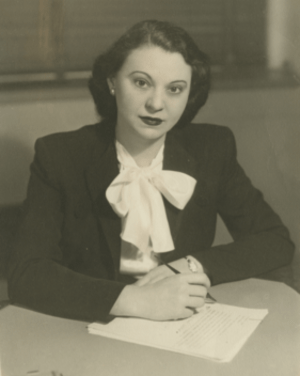Breaking Glass Ceilings: Bessie Margolin and “The Woman Card"
Historically, August is a wonderful month to be a Jewish woman in the political sphere: Ruth Bader Ginsburg joined the Supreme Court on August 10, 1993, and Elena Kagan also donned the austere black robes on August 5, 2010. In 1971, August 26 was named Women’s Equality Day, thanks to the tireless work of Bella Abzug and other Jewish feminists.
So many women have broken so many glass ceilings in the last sixty years that we sometimes forget how isolating it can be to be that first woman in the room, the first woman to push against barriers that seek to keep her in a one-dimensional, mid-level role. In honor of this month of historical victories for Jewish women, I spoke with Marlene Trestman, the biographer of one such unsung woman, Bessie Margolin, and her experiences as a lawyer in the 1940s and as a Jewish female trailblazer in the federal government.
“Bessie Margolin was ‘leaning in’ before Sheryl Sandberg’s mother was born,” says historian, lawyer, and Margolin’s biographer Marlene Trestman. The only woman in her graduating classes at Tulane and Yale, and the only woman on the brilliant legal team that defended FDR’s New Deal, Bessie Margolin was taking charge and opening doors for women while most second-wave feminists were still in diapers.
Born in 1909, Margolin grew up at the Jewish Orphan’s Home in New Orleans and came of age at a time when women made up two percent of lawyers in the United States. Even fewer of those women were Jewish and from the South. With a dearth of role models, Margolin had the audacity to become a lawyer anyway. In 1933, with law degrees from Tulane and Yale, Margolin joined the New Deal’s Tennessee Valley Authority, and then the Labor Department in 1939. After three years on the job, she grew tired of watching the male lawyers around her receive promotions.
Instead of speaking to her (male) bosses, she wrote directly to the first woman appointed to a presidential cabinet—Secretary of Labor, Frances Perkins—and outlined a solid case of what she termed “a general subconscious attitude … a woman is simply not considered for the high ranking positions in the solicitor’s office” Writing this letter in 1942, Bessie Margolin made sex discrimination in the federal government visible twenty-two years before Title VII made such discrimination illegal. Appropriately, as the future Associate Solicitor for the Department of Labor, Margolin would be the key lawyer enforcing, and championing, the Equal Pay Act from its enactment in 1963 to her retirement in 1972.
Margolin’s personal life was populated by men who had to work around her professional goals. Her singularity drew men to her, and she was known for her intelligence, independence, and beauty. In law school, she chose not to marry boyfriend and fellow law student Bob Butler, deciding instead to focus on her career. While at the TVA, she met her intellectual equal (and married boss) Larry Fly, and they began a long affair. As Trestman notes in her book Fair Labor Lawyer, Margolin’s relationship with Fly gave her exactly what she wanted: an intellectual sparring partner, love, and the freedom to focus unapologetically on her career without the entanglements of domesticity. Even later in life, she and another long-time partner, Bob Ginnane, never married. Trestman notes that Margolin did everything on her own terms. “If she wanted to marry, she would have married. I feel confident in saying that Bessie lived exactly the life that she wanted to live.”
In 1945, while Lauren Bacall and Katherine Hepburn were representing women on the big screen, Bessie Margolin was deftly arguing for workers’ rights in front of the Supreme Court. She argued with such finesse, encyclopedic knowledge, and humor that, by the time of her retirement in 1972, she had won 21 out of the 24 cases she presented at the Supreme Court and was accused by Justice Felix Frankfurter of “using her feminine wiles” to sway the judges and protect workers’ rights.
Did Margolin play “the woman card”? According to Trestman, Margolin “played the woman card because it was the only one she was dealt.” In a profession jealously guarded by men, Margolin’s display of femininity was a carefully crafted and calculated way of establishing herself in an arena where she was always going to be perceived as the token woman, regardless of how she carried herself. By being willing to be that token representative, Margolin opened doors for other women to follow in her footsteps.
To hear clips of Margolin arguing cases (with humor and aplomb), you can visit the audio exhibit on Marlene Trestman's website here












Thanks for revealing to us the life and work of this remarkable woman.